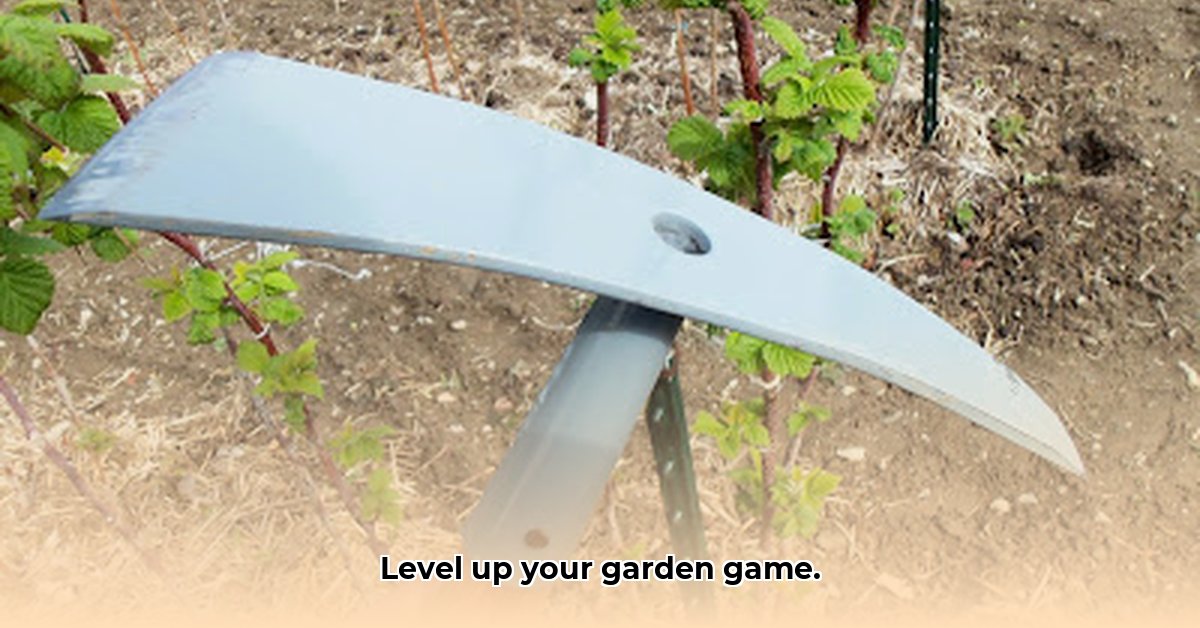
Choosing the right tools is paramount for sustainable gardening. This guide focuses on the grub hoe, a versatile tool vital for efficient and environmentally friendly gardening practices. We'll explore its uses, choosing the best one, and maximizing its lifespan for long-term sustainability. We'll also guide you on where to find high-quality, sustainably-sourced grub hoes, including options at Tractor Supply. For more gardening tools, check out this resource.
Understanding Grub Hoes and Their Uses: The Unsung Hero of Sustainable Gardening
What is a grub hoe, and why is it superior to other hoes like draw hoes or hand hoes for sustainable agriculture? A grub hoe boasts a strong, usually curved blade designed for breaking up compacted soil, removing weeds, and cultivating around plants without root damage. Its versatility makes it a cornerstone of sustainable gardening. It’s exceptionally useful for creating perfectly prepared seedbeds and aerating the soil around established plants.
Think about preparing a new garden bed – a standard hoe might struggle with hard, compacted patches. The grub hoe, however, efficiently breaks through these areas, leaving the soil optimally prepared for planting. Similarly, tackling persistent weeds is easier with a grub hoe's powerful blade which slices through them effortlessly. Its efficiency reduces the need for herbicides, a key tenet of sustainable agricultural practices.
Choosing the Right Grub Hoe: A Comprehensive Guide
Selecting the ideal grub hoe involves several key considerations to ensure both functionality and longevity.
1. Material Matters: Durability and Environmental Impact
The material significantly impacts a grub hoe's durability and environmental footprint.
- Steel: High-carbon steel provides superior strength and resistance to bending or breaking. However, consider the manufacturing process and sourcing. Look for recycled steel options to minimize environmental impact.
- Wood: Wood handles, particularly hardwoods like ash or hickory, offer comfort and a sustainable alternative. Ensure the wood is responsibly sourced from sustainably managed forests. While durable, wooden handles require periodic maintenance.
- Other Materials: Explore innovative options using recycled or sustainably-harvested materials. The more environmentally friendly the material, the better! Research the manufacturer’s sustainability claims.
2. Handle Design: Ergonomics for Comfort and Efficiency
A well-designed handle is crucial for comfort and preventing fatigue.
- Length: Choose a handle length appropriate for your height and the scale of your gardening tasks. Longer handles provide leverage for larger areas.
- Shape: Ergonomic designs minimize strain on your hands, wrists, and back. Consider handle curvature and grip.
- Material: Wood often provides a secure grip, while fiberglass or steel handles offer durability.
3. Head Shape and Size: Matching the Tool to the Task
The head's shape and size directly influence its application.
- Wide Blade: Ideal for covering larger areas, like tilling a whole garden bed.
- Narrow Blade: Offers precision for working around existing plants and tackling weeds in smaller spaces. Perfect for close-quarters weeding.
Consider the specific tasks you'll be performing, choosing a blade size that best suits your needs.
4. Weight and Balance: Finding the "Just Right" Tool
The tool's weight and balance significantly impact ease of use and prevent fatigue.
- Optimal Weight: A well-balanced grub hoe feels like an extension of your arm. Too heavy can lead to exhaustion, while too light might be ineffective.
- Balance Point: The balance point should be comfortably positioned for easy maneuvering and control.
5. Price vs. Longevity: Investing in Sustainable Quality
While cheaper options exist, a high-quality grub hoe offers a significantly longer lifespan, making it a more cost-effective choice in the long run. A well-maintained, durable grub hoe can last decades, minimizing waste and preventing frequent replacements. Think of it as a long-term investment, not just an expense.
Sustainable Practices with Grub Hoes: Minimizing Impact, Maximizing Yield
Grub hoes play a vital role in promoting sustainable gardening practices.
- Reduced Herbicide Use: Efficient weeding with a grub hoe eliminates or drastically reduces the need for chemical herbicides, thus protecting beneficial insects and the environment. This is a critical element of sustainable agriculture.
- Minimized Waste: A durable grub hoe significantly reduces waste compared to frequently replacing cheaper, less durable tools. Proper maintenance further extends its lifespan.
- Soil Health: The process of tilling and aerating the soil with a grub hoe improves soil structure, allowing for better water retention and nutrient absorption. This, in turn, supports healthy plant growth.
Where to Buy Sustainable Grub Hoes: Finding Quality and Ethics
Several retailers prioritize sustainability in their product offerings.
- Tractor Supply Company: Check their inventory for grub hoes made from sustainable materials. Inquire about their sourcing and manufacturing practices.
- Local Garden Centers: These often carry a wide selection of tools, allowing you to examine the quality and compare options.
- Online Retailers: Numerous online retailers focus on sustainable and ethically produced goods. Thoroughly research any company before purchasing. Look for certifications to verify sustainability claims.
Conclusion: Cultivating a Sustainable Garden, One Tool at a Time
Selecting the right grub hoe is a crucial step towards establishing a sustainable gardening practice. By considering factors like material, handle design, and weight, you can choose a tool that will serve you well for many years, minimizing environmental impact and maximizing long-term cost-effectiveness. Remember, investing in quality pays off when it comes to minimizing waste and maximizing the success of your garden.